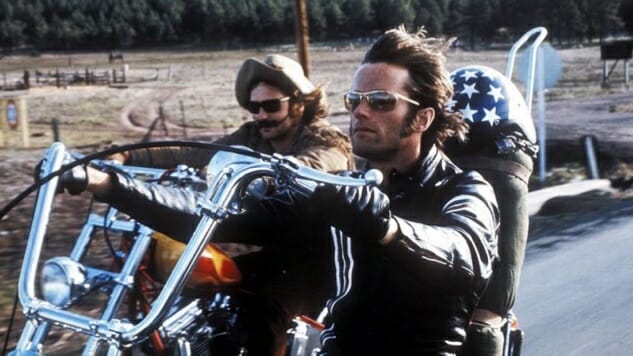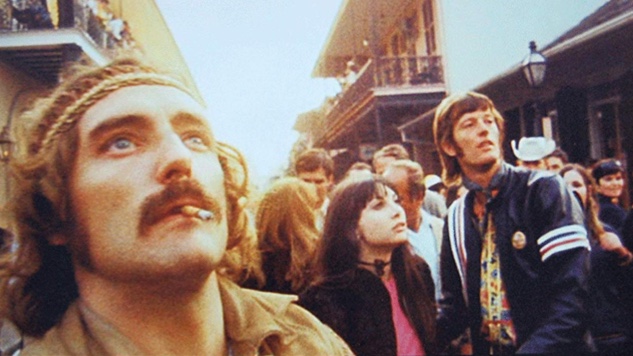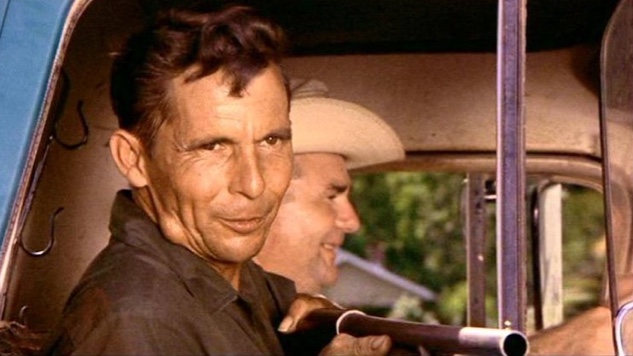
If there’s a quintessential type of American movie—one that shows the land itself and the people in it—it’s probably a road movie. It’s the unique way in which we’ve imposed our mark on the epic hero’s journey, and the only way you could attempt to fit the whole damn country into something as short as a watchable film. The frontiers vanished, and the interstate highway system paved over them.
Lots of people are ready to argue that Easy Rider is that movie. That was certainly its stated goal. It’s a countercultural touchstone, a Boomer fairy tale, and a shot across the bow of a studio system that was in decline and turmoil. At 50, it’s worth it to take a look back at the portrait of America it painted.

Two men make a drug deal (with Phil Spector) and come away with the kind of money that translates to total freedom. Wyatt (Peter Fonda) and Billy (Dennis Hopper, who directed and stubbornly refused to share writing credit with Fonda and Terry Southern in the ensuing years), free from any responsibility or schedule, mount a pair of super cool choppers and roll from Los Angeles to New Orleans, encountering a strange cross-section of Americans along the way.
Any of the individual vignettes of Easy Rider could be its own short film, or another island Odysseus and his storm-tossed crew end up marooned upon: They while away too much time at a hippie commune. They get high as kites during Mardi Gras (scenes shot on 16mm because Fonda spaced on the date and the whole production had to scramble or miss the event). They encounter Jack Nicholson’s southern-fried small-town lawyer and his bizarre alien conspiracy theories.
As naturalistic and off the cuff as it all seems, there’s clear intentionality to every part of the story, even the numerous needle drops and the long, loving scenes of the two 20th century cowboys on their steeds rolling through the American West. That hippie commune is fun and free-wheeling, but it’s not sustainable. Mardi Gras is a blast, but it isn’t what Wyatt and Billy were looking for. Nicholson’s character is wise, but he doesn’t make it to the parish line.
Wyatt and Billy’s epic journey ends in random violence—something which dismayed Bob Dylan, who wrote the closing song (uncredited). In a 1995 documentary, Fonda said that he wanted people to have to sit with that ending. It’s hard to imagine a more fitting one, if you’re going to tell a true story about the country.

There’s not a lot to the plot of Easy Rider, and some stretches of it amble and linger. Hopper originally cut the thing to be over four hours long, and he, Fonda, Jack Nicholson and others spent more than 22 weeks re-cutting it into the hour-and-a-half version that stormed Cannes.
It was a sensation, and one that began to bring the counterculture into a position of prominence in Hollywood. The Hays Code was dead, the old studio system was faltering, and method acting was in. The separation between a film like, say, The Wild One and one like Easy Rider was immeasurably wider than the 16 years that separated them.
Easy Rider wasn’t solely responsible for the aesthetic shift in American films that occurred around that time, but it had a hand in it.

There’s also the undeniable effect Easy Rider had on motorcycle culture. As the proud owner of a hog myself, there’s no question I have many times mentally priced out a tear-drop tank with an American flag paint job and Schott jacket to match. Choppers as an art form and a design challenge made their way overseas on the back of Easy Rider. Besides being all the other significant things it is, Easy Rider is also absolutely, as my girlfriend called it, “straight-up motorcycle porn.”
There’s just one little detail about those bikes (which were apparently stolen prior to the film’s release): Their creators never got their due credit.
Absent from the film’s credits and from the 1995 and 1999 documentaries on the making of the film are any mention whatsoever of Ben Hardy and Clifford Vaughs, two of the men who were most chiefly responsible for building Billy and Wyatt’s bikes. Hardy and Vaughs are black.
One recurring theme throughout Easy Rider is the discrimination the two protagonists face—denied service at hotels, they camp out in nature. When they sit down to get one measly plate of food at a diner in the deep South, they’re met with a chorus of homophobic, anti-hippie jeering from a bunch of good ol’ boys who later follow them out into the country and beat Nicholson’s character to death. The film ends because some yahoo asshole in a truck randomly guns them down.
There are no black speaking roles in this movie.
Hardy died in 1994, but Vaughs has in recent years responded to interview requests to express some bitterness over essentially getting frozen out of recognition for his part in weaving part of the fabric of modern America.
“Why is it that we have a film about America and there are no negroes?” Vaughs said in a 2014 interview with NPR.
Vaughs, a newsman at a radio station, met Fonda when the latter was in court on a drug charge, giving the two occasion to chat motorcycles (as all bikers naturally will). In addition to his journalism career and participation in civil rights activism (he once got punched while photographing black constituents waiting in line for a voter registration test), Vaughs was also a gearhead, and offered his services for Fonda’s quirky little indie film. That is how we got the star-spangled chopper with its monkey-hanger handlebars and a front end like a stretch limo. It’s one of the reasons why bike culture spread around the globe, why there are shows like American Chopper.
If you think this means I am arguing that Easy Rider is not an accurate portrait of America—quite the opposite: It is, for better and worse, a beautiful and iconic movie that is a perfect example of what we tell ourselves about ourselves, and who gets left out of the telling.
Kenneth Lowe flows out to the sea. You can follow him on Twitter and read more at his blog.